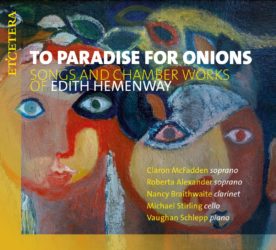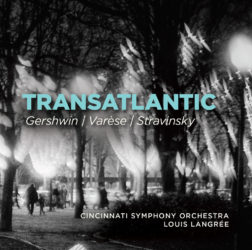Classical CD Reviews: “To Paradise For Onions,” “Transatlantic,” and “Die Zauberflöte”
By Jonathan Blumhofer
To Paradise For Onions is a lovely album; Cincinnati Symphony Orchestra ‘s Transatlantic is spirited; Yannick Nézet-Séguin’s Die Zauberflöte is lost in the crowd.

To Paradise For Onions is, by a pretty wide measure, the most whimsical album title I’ve come across in 2019. A compilation of art songs and chamber music by Edith Hemenway, a 92-year-old composer who now lives in Providence, RI, it has its droll moments, yes; but also, poignant, spirited, and turbulent ones, too.
The songs – settings of poems by W. S. Merwin, Robert Louis Stevenson, and Langston Hughes – are, by and large, elegant and lyrical. In the Merwin set, Doors, a solo clarinet and cello weave around the vocal line, creating a series of gently shifting contrapuntal textures.
A Child’s Garden of Verses, Hemenway’s Stevenson collection, is similarly fluid and mellifluous. “Where go the Boats?”, with its undulating accompaniment and floating vocal line; the wild “Windy Nights”; and folk song-like “The Cow” are among its highlights.
Hemenway’s beautiful Four Poems of Langston Hughes, for two sopranos and piano, rounds out the disc’s vocal offerings. Her writing here ranges from a tangy setting of “Island” to the bluesy “Down and Out,” followed by a prayerful “Midwinter Blues” and a rolling “Hope.”
In each of the vocal works, the texts are set cleanly and clearly: even when the vocal line soars into the stratosphere (as it does in the first “Doors” song), the words are understandable. And Hemenway’s accompaniments manage to be plenty characterful without once getting in the way of the voice. They recall, in their expressivity and approach to the form, the best art songs of the last half century by Ned Rorem, André Previn, Benjamin Britten and others.
Three instrumental works – all of them inspired by poems – are interspersed between the songs.
The first, Questions of Travel, is a set of seven short, almost aphoristic movements for clarinet, cello, and piano based on Elizabeth Bishop’s eponymous verse. Hemenway writes a series of lively contrasts between them: spluttering arpeggios in “Waterfalls”; a stately, mysterious processional in “Journey of the Ancients”; chugging ostinatos and sudden squeals in “The Rented Car.”
The title track, a piece for clarinet and piano, craftily adapts part of F. M. Ford’s “When the World was in building”: there’s a beguiling section in a 13/8 meter that evokes a punting stroke and the closing pages provide a pristine etching of the arrival of twilight.
Asian Figures is another set of miniatures, these derived from Merwin poems. Its nine movements range from the delicate “Autumn rides down on one leaf” to the soulful “Ferns bend into the water” and the playful “It’s only where pretty girls live.”
The performers – sopranos Claron McFadden and Roberta Alexander, clarinetist Nancy Braithwaite, cellist Michael Stirling, and pianist Vaughan Schlepp – deliver top-rank readings of these pieces. Braithwaite, in particular, shines: she makes the most of Hemenway’s idiomatic but highly expressive lines for her instrument. And Schlepp’s accompaniments are perfectly calibrated, colorful, but discreet.
Indeed, this is a lovely album. While none of the individual tracks are particularly long (To Paradise For Onions runs about 7:40; none of the remaining twenty-nine tracks lasts more than five minutes), Hemenway’s writing is conspicuously rich and rewarding throughout. She’s crafted a series of little gems here that deserve to be heard and played widely.

Edgard Varèse’s Amériques is the sort of piece that could only have been written in the 20th-century United States: brash, spastic, in-your-face, filled with allusions musical and not. And yet…the score’s sense of color, line, and shape is decidedly European. It’s undeniably a piece with a personality, and that sense of self comes across with brilliant assurance in a striking new disc from the Cincinnati Symphony Orchestra (CSO) and music director Louis Langrée.
The album pulls together pieces by Varèse, George Gershwin, and Igor Stravinsky in a program that both celebrates their historic ties with the CSO and also examines the subject of place – geographic, stylistic, aesthetic – in music.
Amériques, is Varèse’s tribute to his adopted country. It’s heard here in its monster, 1922 original version, and ends up serving as the program’s anchor. The CSO’s performance is, by turns, spunky, plangent (listen to those gorgeous, faux-Debussy flute solos), and terrifying. Throughout, the reading is winningly shaped; ablaze with color, crisp rhythms, and bold displays of virtuosity. If you don’t automatically think of the CSO among the top-five American orchestras, on the merits of this performance alone, you should: they swagger with the best of ‘em.
Their account of Stravinsky’s Symphony in C is likewise bracing. Langrée’s is an interpretation that is decidedly neo-Classical: texturally lean and tonally warm, while mining the lyricism of Stravinsky’s writing without giving short shrift to the rhythmic stimulus that lies beneath it. The results are deliciously personable and three-dimensional.
Rounding things out are two performances of An American in Paris, both debut recordings of the work’s new critical editions (of, respectively, its full and abridged versions).
What have we been missing? Mostly subtle things. Basically, Gershwin’s original scoring has been restored, which results in some brasher woodwind textures and a broader array of percussion instruments (plus retuned car horns).
Langrée and the CSO turn in spirited, ebullient readings of both versions, as good, spiritually, as any of the classics from the Boston Pops or New York Philharmonic. They’re perfectly-considered bookends to an album that showcases one of the country’s best orchestras in a most impressive light.

There are more than a few things to admire in Yannick Nézet-Séguin’s new recording of Mozart’s Die Zauberflöte. His tempos are lively, the playing he draws from the Chamber Orchestra of Europe (COE) consistently lively and clean-textured, and there are boldly colored episodes that ensure this reading never veers towards dullness.
Nézet-Séguin’s cast, though, leaves a bit more to be desired.
Klaus Florian Vogt proves, for the most part, a fresh-toned, youthful Tamino – that is, until his voice gets raw and starts to call to mind René Kollo’s edgy Heldentenor. I’m rather partial to the last, at least in Tannhäuser and Parsifal, but there doesn’t seem to be much rhyme or reason to Vogt’s shifts of tone in this Zauberflöte. What’s more, there’s not much personality to his overall performance – or discernable chemistry between him and Christiane Karg’s pristine Pamina.
Not to worry, Rolando Villazón’s Papageno is dogged by similar issues of indistinctiveness. He’s got the notes, certainly, but his reading of the part veers widely: “Der Vogelfänger bin ich ja” is brawny while “Ein Mädchen oder Weibchen” lunges to the opposite extreme. The scenes in between include the urgent (“Papagena! Papagena!”) and the more measured (“Schnelle Füsse, rascher Muth”). In the end, it’s a bit too much like several personalities in search of a character than the one might like.
The less said about Albina Shagimuratova’s Queen of the Night perhaps the better. Suffice it to say, her vibrato gets in the way of her rhythm in both of her character’s big arias and, while the high notes are hit square-on, that doesn’t make up for the difference. Paul Schweinester’s Monastos is likewise bland and forgettable.
On the plus side, there’s Karg’s aforementioned Pamina; Franz-Josef Selig’s noble Sarastro (“In Diesen heil’gen Hallen” is one of the recording’s gems); and Regula Mühlemann’s silvery Papagena is a delight. Also, the choral singing and the other small-ensemble moments (for the priests and three boys) are all finely done.
Still, there are – what? Eighty-plus? – other recordings of Die Zauberflöte out there and this one doesn’t top the best of those (among which you’ve at least got to count Solti, Levine, Davis, and Böhm). Nézet-Séguin’s has its charms but it doesn’t exceed the sum of its parts.
Jonathan Blumhofer is a composer and violist who has been active in the greater Boston area since 2004. His music has received numerous awards and been performed by various ensembles, including the American Composers Orchestra, Kiev Philharmonic, Camerata Chicago, Xanthos Ensemble, and Juventas New Music Group. Since receiving his doctorate from Boston University in 2010, Jon has taught at Clark University, Worcester Polytechnic Institute, and online for the University of Phoenix, in addition to writing music criticism for the Worcester Telegram & Gazette.
Tagged: Colophon, Deutsche Grammophon, Die Zauberflöte, Fanfare Cincinnati/CSO Media, To Paradise for Onions
